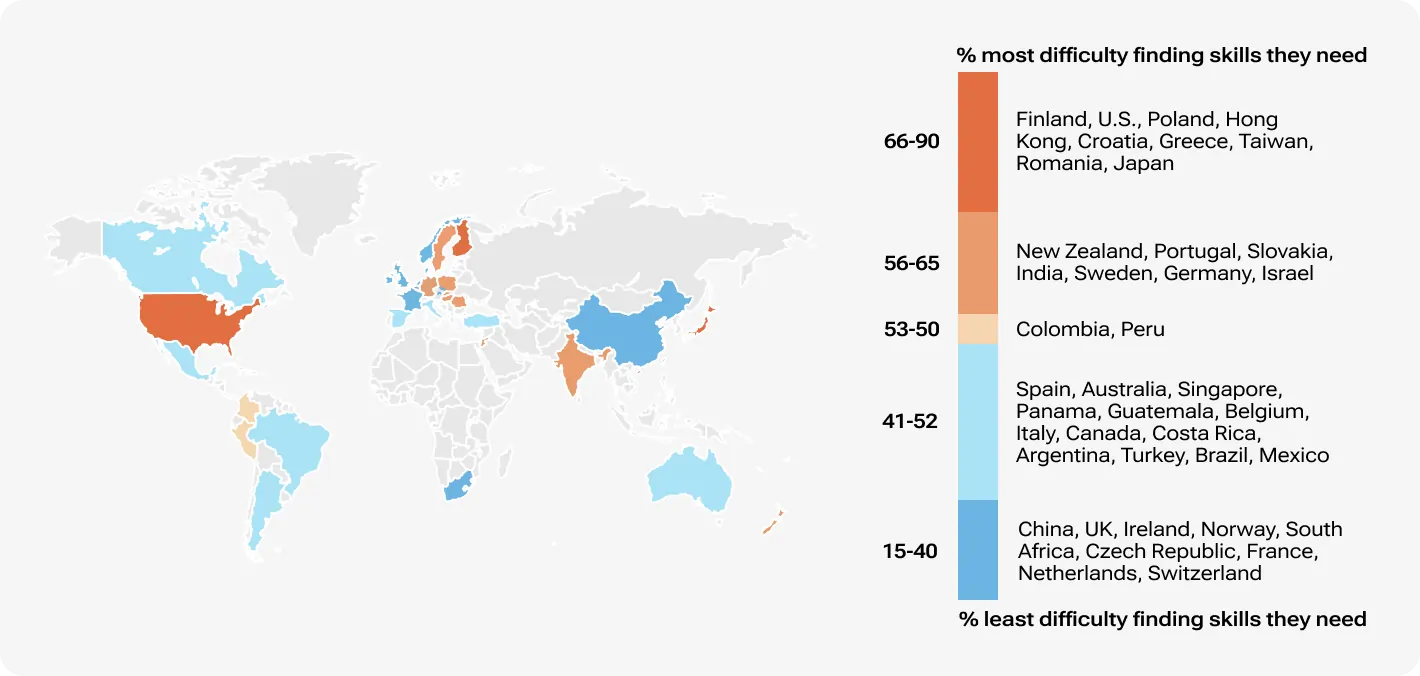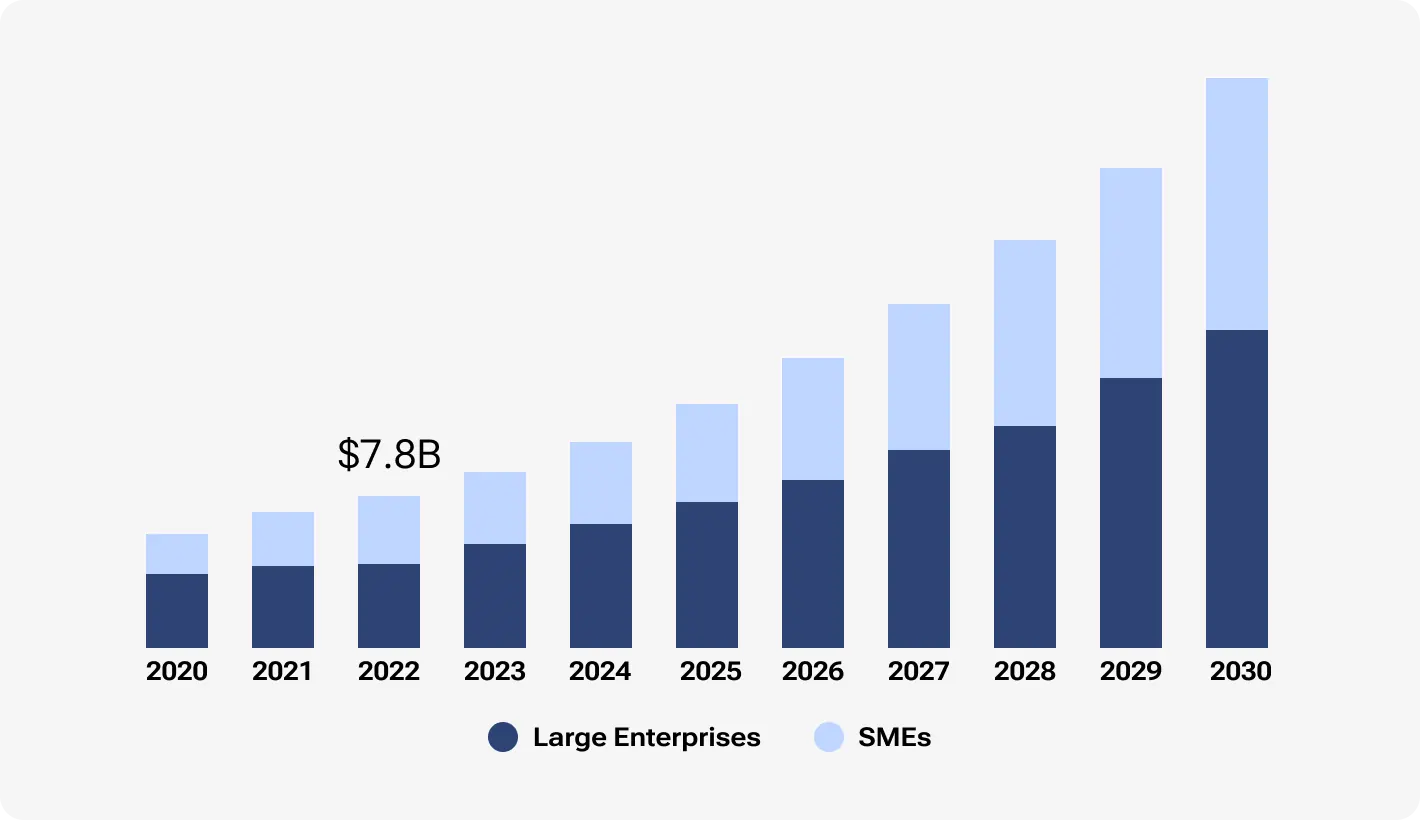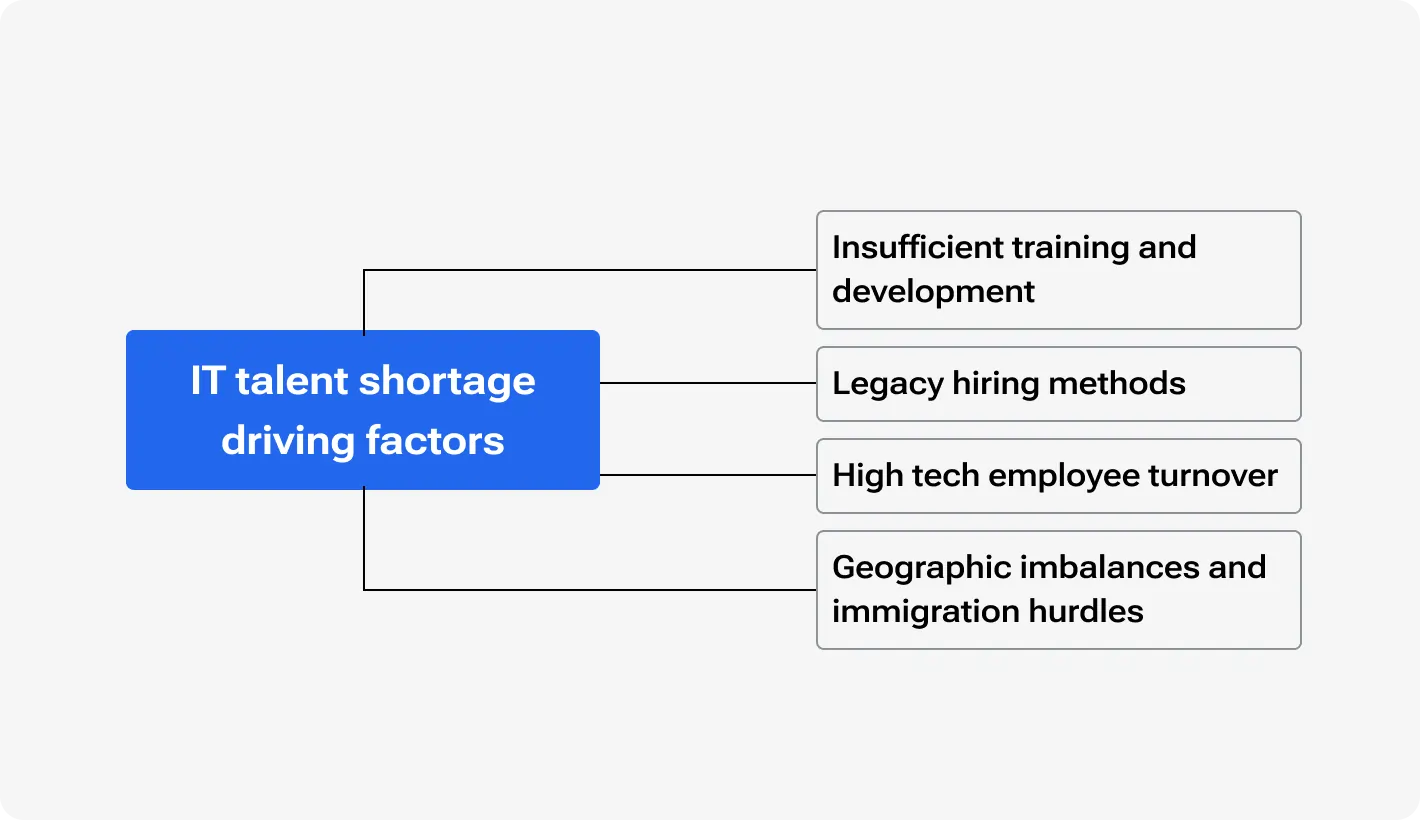Outsourcing to Czechia

How much does it cost to hire developers in Czechia?
Dec 2nd 25 - by Devico Team
Find out how much it costs to hire software developers in Czechia in 2025. Compare hourly rates, roles, and factors that impact pricing.
Hire
Hire by role
Hire Front-end developers
Hire Back-end developers
Hire Full-stack developers
Hire Android developers
Hire iOS developers
Hire Mobile developers
Hire AI engineers
Hire ML engineers
Hire Automation QA engineers
Hire Blockchain developers
Hire Data engineers
Hire Cloud engineers
Hire by skill
Hire JavaScript developers
Hire TypeScript developers
Hire Ruby on Rails developers
Hire React Native developers
Hire Flutter developers
Hire Golang developers
Hire React.js developers
Hire Python developers
Hire PHP developers
Hire .NET developers
Hire Java developers
Hire Laravel developers

Staff augmentation
January 30, 2025 - by Devico Team
Summarize with:
The global tech talent shortage is a pressing issue for businesses worldwide. According to the Bureau of Labor Statistics, by 2026, the shortage of software developers in the United States alone will reach a whopping 1.2 million. Such a massive number will naturally translate into billions of losses. Currently, the United States faces one of the most pressing IT talent shortages in years, with up to 90% of US employers struggling to find the right skills.

Gartner states,
The data and insights above show that companies worldwide struggle with the shortage of tech talent, making it increasingly difficult to fill key IT roles.
In this article, we’ll look at the main reasons behind the tech labor shortage and explore how to close the tech talent gap that continues to widen.
The global job market is evolving so quickly that many players are unable to keep up. The tech industry sits at the heart of these changes. Lockdowns, remote work policies, and expanding digitalization requirements have contributed to the growing tech labor shortage by reshaping the workforce and increasing demand for skilled IT professionals. All of that in the context of the skyrocketing market for customer software development.

Businesses, big and small, rely on apps, cloud services, and data analytics to stay competitive. Such a reliance on technology has further contributed to the tech talent gap, making skilled professionals harder to find. There's an urgent need for skilled IT professionals, as a result. Here are some key changes affecting the overall job market.
In many countries, the IT talent scarcity is becoming more severe as the demand for IT roles continues to outpace the available supply. According to this report, the high demand for software development roles will likely continue past 2026.
One should also note that beyond development roles, companies seek
data scientists;
cloud specialists;
cybersecurity experts.
The aforementioned positions are the key to promoting digital transformation while keeping new systems safe and sound.
A recent survey by Gartner pointed out that after COVID-19, the majority, about 74% of companies, planned to shift their workforce to remote mode. Looking at the current state of affairs, according to Statista, the number of employees within the technology industry stands at about 67%. The trend is clear — even amid a tech labor shortage, more and more IT companies embrace remote work to tap into global talent.
In addition, as more companies adopt flexible work setups, they gain access to talent worldwide. Yet, this advantage cuts both ways — global competition also increases, and local professionals now compete with candidates from other regions who may have similar or superior skill sets.
As the abovementioned evidence dictates, there is a struggle to recruit the right professionals. As per Deloitte, the shortfall is especially critical in artificial intelligence (AI), cybersecurity, and cloud computing.
Hiring managers struggle to recruit the right professionals due to the intensifying IT talent scarcity across both established and emerging tech markets. Naturally, the case for hiring managers will be even more dire, considering that 55% of CEOs around the world expect to boost their hiring initiatives this year.
In the end, the talent shortage in 2025 is one of the key driving forces behind the existing job market.
Technologies like ML, blockchain, and IoT have widened the tech talent gap, spawning roles that didn’t exist just a few years ago. Traditional education programs struggle to keep up with the rapid pace of change, leaving companies with unfilled niche positions. In the context of evidence suggesting the tech talent shortage can cost up to $8.5 trillion by 2030, changing and adapting how people are taught is paramount.
Large companies like Google, Microsoft, and Amazon offer competitive salaries and perks, which draws top candidates away from smaller firms. As a result, mid-sized businesses and startups (SMEs) must adapt and explore more creative methods, such as staff augmentation or global hiring. All for the sake of staying competitive with big players on the market.
According to the U.S. Bureau of Labor Statistics, jobs in IT are projected to grow by 22% from 2020 to 2030. In the face of a widening tech labor shortage, smaller companies struggle to match the salaries, benefits, and prestige offered by tech giants. This discrepancy intensifies the shortage of qualified applicants in the broader market.
These factors — from immigration issues to competitive hiring — intensify the tech talent shortage, especially in high-growth sectors. Naturally, the changes in the workforce market hamper one’s ability to innovate and be competitive.
Now, let’s go through the internal factors driving the tech labor shortage.

The shortage of IT talent circles around different causes. These contribute to a market where demand overwhelms supply.
Rapid tech evolution moves faster than educational systems or approaches can handle. University curricula struggle to keep up with new programming languages and tech frameworks. Short certification programs try to fill the gap.
Yet, the existing approaches are clearly not enough to create a steady flow of experts with the right qualifications. As a result, a skills shortage emerges. The students and junior professionals simply aren’t prepared for real-world challenges.
Some organizations and businesses still rely on old-school hiring methods. Standard interviews, long application processes, numerous test tasks, you name it. These outdated processes are part of why the tech labor shortage persists — top talent expects more efficient recruitment.
Top developers and data scientists prefer clear and transparent hiring steps. Skilled candidates move on to more flexible employers when companies fail to adapt.
How does the offshore time difference work in your favor?
Employee retention is a big factor. Skilled tech workers usually receive multiple job offers. In other words, experts in demand change the workplace often. For any company, it means higher attrition.
Such a churn creates a talent shortage. Because companies simply lose vital knowledge every time an expert walks out. Don’t forget that companies are also pushed back into the hiring cycle, which further strains the limited pool of available specialists.
“Tectonic” shifts are happening right now. New global political powers and changing policies toward immigration fuel the tech talent shortage. Knowledge workers or highly skilled IT professionals have the means and try to find locations offering the most stable conditions.

In such a case, there are places around the world that lack strong tech ecosystems or have stricter immigration laws. These and other factors make bringing in needed specialists from abroad harder. With policies on remote work becoming a norm, securing specialist barriers shrinks but never entirely vanishes.
Key point:
The IT talent shortage is rooted in
Collectively, the factors we mentioned create a significant tech talent gap. To address the variables behind the talent shortage, businesses need to rethink their strategies.
Here’s more on the solutions and not the problem itself.
While businesses face the consequences of a talent shortage, their practices and decisions can also contribute to the problem.
Hiring new employees during an IT talent shortage comes with significant costs that can impact a company’s bottom line. According to a Gallup report, replacing a worker can be expensive, with costs ranging from 50% to 200% of the employee's annual salary. This underscores the importance of not just attracting but also retaining top talent.
Moreover, while the average onboarding program lasts about 90 days, it typically takes new employees around a year to reach their full potential in terms of performance. This means that during the first year, businesses often invest time and resources into training and developing employees before they can fully contribute to the team's success.
Finding and onboarding qualified candidates has become increasingly time-consuming and resource-intensive due to the current talent shortage. Companies are facing longer recruitment cycles as they work to identify candidates who not only have the right skills but also fit well within their company culture. Additionally, the process of onboarding has become more complex, as new hires need support to acclimate to the company's systems and processes.
How to keep your project on track during employee turnover?
The ongoing shortage of tech talent is taking a significant toll on employees, contributing to burnout and decreased productivity. Although the prevalence of employee burnout has slightly decreased according to the HR Trends report, a staggering 65% of employees continue to experience burnout. This indicates the pressure and stress associated with meeting workforce demands.
One of the most concerning consequences of burnout is its impact on employee performance. A significant majority, 72%, of employees have reported that burnout has impaired their productivity. This not only hampers individual performance but also affects the overall well-being and success of the company.
The talent shortage has created a perfect storm that is pushing employees to their limits, leading to decreased motivation, demotivation, and increased absenteeism. Long-term, such burnout might be followed by a lack of job satisfaction, higher rates of turnover, and higher recruitment costs.
The workplace landscape currently poses many challenges for businesses. It is now imperative that special attention be paid to employee well-being and a work environment that is sympathetic to the burden of working in a talent shortage. This is the way forward in limiting burnout while preserving positivity and productivity in workers who drive the business.
Companies that prepare for the 2025 talent shortage can lead their fields.
Below are practical ways to address the IT talent shortage head-on, from hiring innovations to smarter workforce strategies.
A focus on a formal degree or years of experience can exclude viable applicants with adaptable soft skills or the ability to learn quickly. Hiring managers should instead prioritize a candidate’s potential:
Transferable skills. Applicants might not know a particular programming language but can adapt if they have strong problem-solving abilities.
Flexible training. In-house mentorship or boot camps can transform motivated newcomers into valuable team members.
A shift like the one above expands the talent pool and helps companies remain competitive despite the tech talent shortage.
Sometimes, the best candidates are right in front of you. Senior staff and mid-level specialists may be waiting for a chance to grow:
Upskilling/reskilling. Offer courses as well as workshops in high-demand domains like ML or DevOps.
Career paths. Provide a clear route for promotion. Employees stay longer when they see real growth potential.
Internal promotions reduce hiring costs. They also make sure the right knowledge is kept in your company.
Team augmentation is expected to reach $857 billion by 2031 compared to the market’s last valuation of $299 billion in 2023. With the method in the arsenal, a firm can quickly fill skill shortages by bringing in specialized developers, testers, or engineers from an external partner:
On-demand expertise. Augmented teams address immediate project needs without a lengthy hiring process.
Scalable model. You can add or remove specialists based on workload, which helps manage budgets effectively.
Universities, coding boot camps, and vocational schools. There are places to look for new talent. Helping universities align their curricula with industry needs is a strategic move to reduce the tech talent gap before it widens further. Your company can play a key role in this training.
Early talent pipelines. Offer workshops and paid internships. Builds rapport with the most promising graduates before someone else on the market hires them.
Practical curriculum input. Work with educators to keep the course content up-to-date. This will ensure new graduates can deal with new programming languages and tech novelties.
Closer academic partnerships can provide a steady flow of junior talent. They will be eager to learn more as well as grow within your company.
Traditional methods of recruiting often miss out on top candidates.Modernizing recruitment with smarter strategies and digital tools is crucial in the face of today’s tech labor shortage. It can also make sure top talent is more attracted toward a position your company offers.
Efficient screening. Use application tracking tools (ATT) for résumé reviews and initial interviews. In such a case, you can shorten the overall hiring process.
Hackathons and challenges. Host live coding or design competitions that let candidates showcase their skills. Let them show off themselves and learn about your workplace at the same time.
The market needs a proactive and diverse strategy to tackle the tech talent shortage. Firms must do at least the following:
Rethink traditional hiring processes;
Invest in internal staff development;
Use IT staff augmentation (perhaps, the best approach).
These steps will help them find the skilled professionals essential for success.
Using external specialists lets companies access rare skills. They avoid the full costs of permanent hires.
Here are ways augmenting your IT talent can help with the overall tech talent shortage.
Outsourcing tasks or projects lets you access a global pool of programmers, data scientists, and UX/UI specialists. This method is vital for ML, AI, RPA, blockchain, and many more niche fields. In these areas, it can be tough to find local experts.
Staff augmentation offers a dynamic way to add or reduce team size. A company can quickly adapt to shifting project requirements on the go.
A better mix of in-house and augmented staff lets you handle sudden workloads or short projects without overstaffing.
Companies must promptly adopt new tech frameworks in an era of fast technological shifts. Staff augmentation makes it simpler to bring in specialists with in-demand skills:
Fast deployment. Start new initiatives without waiting months to hire tech talent.
Immediate Return on Investment (ROI). Reduce the time it takes to launch needed-to-the-market products or features.
External teams are the source of fresh ideas. They bring cross-industry expertise that helps overcome the shortage of tech talent by introducing fresh perspectives and proven frameworks. In addition, they often faced the same challenges and might have found solutions your teams never thought about. Their experience helps them offer new approaches. Introducing new methods boosts innovation.
Devico is more than a typical staff augmentation service company. We offer flexible on-demand talent, global expertise, and cost savings strategies. Our approach removes the usual HR and operational barriers, letting you focus on strategic growth. Below are some of the advantages you can expect with our tech staff augmentation services:
Skilled talent with broad experience. We maintain a global pool of software developers, QA professionals, and data experts. Each is carefully vetted and prepared to join your project from day one.
Flexible engagement models. Whether you need short-term specialists for a single sprint or an entire team for an extended project, we can adapt. This structure keeps budgets under control while maintaining high standards.
Fast onboarding. We reduce onboarding time by matching you with talent who already know your industry. You can kick off top-priority tasks and projects from the get-go.
Measurable cost reduction. Devico often provides savings of up to 40% compared to local hires. We handle admin tasks and HR overhead so your core team can focus on critical goals instead of day-to-day operations.
Consistent quality and retention. We invest in training and motivating our teams, which lowers turnover and provides reliable specialists for your projects.
Clear communication along with clear processes. We keep you updated on everything: milestones, bottlenecks, deliverables, budget changes, and much more. Transparent communication is essential when working with external teams, especially during a global tech talent shortage where project speed and clarity are non-negotiable.
Working with Devico for staff augmentation reduces operational headaches, speeds up delivery, and offers dependable professionals. You can have a single, trusted partner for most of your outstaffing needs.
Dealing with the tech labor shortage stands on the given triad:
Proactive mix of hiring strategies;
Internal growth;
External partnerships.
The good news is that solutions exist. Shifting to potential-based hiring expands your talent pool. Promoting from within keeps high performers on board.
Staff augmentation is a practical option to address the tech talent shortage in 2025 head-on. The tech talent shortage is a big challenge. Luckily, companies, from big to small, can lessen their impact with proactive strategies. They can change hiring practices, promote internal talent, and use the team augmentation approach. These solutions help bridge the tech talent gap.
Outsourcing to Czechia

Dec 2nd 25 - by Devico Team
Find out how much it costs to hire software developers in Czechia in 2025. Compare hourly rates, roles, and factors that impact pricing.
Outsourcing to Czechia

Nov 25th 25 - by Devico Team
Compare Czechia and Poland for software outsourcing in 2025. Discover costs, talent, infrastructure, and which country fits your project best.
Outsourcing to Czechia

Nov 18th 25 - by Devico Team
A complete guide to outsourcing software projects to Czechia, learn about costs, talent, benefits, and how to build successful partnerships in 2025.